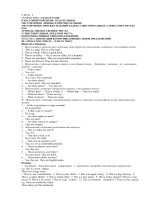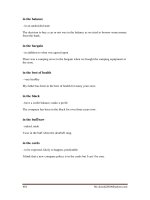Education english 1 ppt
Bạn đang xem bản rút gọn của tài liệu. Xem và tải ngay bản đầy đủ của tài liệu tại đây (101.34 KB, 6 trang )
CHAPTER 4 • LearningExpress Skill Builders
94
There are 230 kids total because 92 is 40% of 230.
You can check your answer: .4 ϫ 230 ϭ 92.
GEOMETRY
1. c. Notice that this figure contains similar triangles.
Similar triangles are in proportion. Because
AB:BD ϭ 2:3, then we know that the triangles are
in a 2:5 ratio.
This means that the bases of these 2 triangles will
also be in a 2:5 ratio.
2. b. A pentagon has five sides. If a pentagon is reg-
ular,that means that all five sides are equal. To find
the perimeter,we just add up the distance around
the pentagon.
25ϩ25ϩ25ϭ25ϩ25 ϭ 125 mm.
3. a. First, notice the triangle in the middle of the
rectangle. All triangles have 180°, so we know that
the 3rd angle is 50°. (95° ϩ 35° ϩ 50° ϭ 180°)
Next, notice how this question is similar to a Par-
allel Lines question:
Angle p and 50° are alternate interior angles, and
are thus equal: p ϭ 50°.
4. b. The slope is calculated by using the formula
m ϭ
ᎏ
Δ
Δ
x
y
ᎏ
,where m is the slope of the line.
We will use the points (Ϫ3, 5) and (8, 10) in the
slope formula:
m ϭ Δy ϭ
ᎏ
y2
Δ
–
x
y1
ᎏ
ϭ x2 – x1
ϭ
ᎏ
8
1
–
0
(
–
–
5
3)
ᎏ
ϭ
ᎏ
1
8
0
ϩ
–
3
5
ᎏ
ϭ
ᎏ
1
5
1
ᎏ
5. a. A reflection is like a mirror image. If we are
reflecting the figure across the y-axis, then we are
making a mirror image of it across the vertical axis.
Choice a meets this description.
95
o
50
o
35
o
p
A
CD
B
SBGeo_1 SBGeo_2 SBGeo_3
SBGeo_4
SBGeo_5
SBGeo_6
SBGeo_7
SBGeo_8
SBGeo_9
SBGeo_10
5
5
5
5
5
SBGeo_14
SBGeo_15
SBGeo_17
SBGeo_18
SBGeo_19
SBGeo_16
A
BC
DE
2
2
5
3
SBGeo_20
–BASIC SKILLS FOR COLLEGE–
LearningExpress Skill Builders • CHAPTER 4
95
6. c. Notice how the diagonal is really the hypot-
enuse, c, of a right triangle:
We can use the Pythagorean theorem, a
2
ϩ b
2
ϭ
c
2
. This equation becomes 4
2
ϩ 4
2
ϭ c
2
, or 16 ϩ
16 ϭ c
2
, or 32 ϭ c
2
. This means that c = ͙32
ෆ
.
͙(32)
ෆ
ϭ ͙(16 ϫ
ෆ
2)
ෆ
ϭ 4͙2
ෆ
.
7. c. The missing angle must be 70° because all the
angles inside a triangle add up to 180°. Notice that
there is a 6 opposite the 70° angle in the figure.
The side opposite the newly-labelled 70° angle will
also be 6, because equal sides are opposite equal
angles.
To calculate the perimeter,you just add up all the
sides: 5 ϩ 6 ϩ 6 ϭ 17.
8. c. The third side of the triangle must be less than
the sum of the other two sides (17 ϩ 14) and
greater than their difference (17 Ϫ 14). This
means that the third side must be less than 31 and
greater than 3. Only choice c fits these criteria.
9. d. Looking at the diagram, we can fill 40 for the
angle created when the line crosses ST.
This is because the line will create corresponding
angles for all the parallel lines that it crosses. This
newly labeled 40° angle and angle a make a straight
line. Because straight lines are 180°, we know that
angle a must be 140° (40° ϩ 140° ϭ 180°).
10. d. Looking at the diagram we can fill in some 40°
angles because we know that the intersecting line
will generate corresponding angles for all the
parallel lines that it crosses.
Notice how the 40° under angle b and angle b cre-
ate a straight line. Because straight lines are 180°,
we know that angle b must be 140° (40° ϩ 140°
ϭ 180°).
OP
QR
ST
UV
b
o
a
o
40
o
40
o
40
o
OP
QR
ST
UV
b
o
a
o
40
o
40
o
SBGeo_1 SBGeo_2 SBGeo_3
SBGeo_4
SBGeo_5
SBGeo_6
SBGeo_7
SBGeo_8
SBGeo_9
SBGeo_10
40
o
70
o
70
o
66
5
SBGeo_14
SBGeo_15
SBGeo_17
SBGeo_18
SBGeo_19
SBGeo_16
AB
C
D
4
c
SBGeo_20
–ESSENTIAL PRACTICE WITH MATH–
CHAPTER 4 • LearningExpress Skill Builders
96
11. d. All quadrilaterals (four-sided figures) have
360°, so M and O have 360°. Figure N has five sides.
The formula for figuring out the number of
degrees in a polygon is: (n Ϫ 2) ϫ 180, where n
is the number of sides. This means that figure N
has (5 Ϫ 2) ϫ 180 ϭ 3 ϫ 180 ϭ 540°. Thus d is
the correct answer.
12. b. The area formula for a parallelogram is Area
ϭ base ϫ height ϭ bh. We will need to figure out
the height of the parallelogram. Notice the right
triangle created by the dashed lines in the figure
below:
You can use the Pythagorean theorem, a
2
ϩ b
2
ϭ
c
2
to determine that the height is 6. (8
2
ϩ h
2
ϭ 10
2
;
64 ϩ h
2
ϭ 100; h
2
ϭ 36, thus h ϭ 6). Then put
the dimensions into the area formula: Area ϭ bh
ϭ (8)(6) ϭ 48.
13. a. Because triangle ABC is similar to triangle
XYZ, we know that their sides are in proportion
with one another. Since these similar triangles are
referred to as ABC and XYZ, we know that A
corresponds with X, B corresponds with Y, and C
corresponds with Z.
The figure shows us that AB is 4, and that the
corresponding side for the bigger triangle, XY, is
12. Compare 4 to 12.You should notice that 12 is
three times 4. This means that every side on the
bigger triangle is three times the smaller one’s.XZ
would be three times AC: 3 ϫ 6 ϭ 18. YZ would
be three times BC: 3 ϫ 5 ϭ 15. Adding the two
sides together, we have: 18 ϩ 15 ϭ 33.
14. c. Perpendicular lines have slopes that are nega-
tive reciprocals of each other. Remember that
the slope is the m on the formula y ϭ mx ϩ b.The
given line has a slope, m, equal to Ϫ5. First take
the reciprocal of Ϫ5. Ϫ5 is the same as Ϫ
ᎏ
5
1
ᎏ
. To take
the reciprocal, we just reverse the numerator and
denominator: Ϫ
ᎏ
1
5
ᎏ
. We also need to take the neg-
ative of this: Ϫ(Ϫ
ᎏ
1
5
ᎏ
) ϭϩ
ᎏ
1
5
ᎏ
. Only choice c has m
ϭ
ᎏ
1
5
ᎏ
.
15. b. The area of a circle is A ϭ πr
2
. Here we know
that the area is 36π, so 36π ϭ πr
2
. Note that you
can divide both sides by π to get 36 ϭ r
2
. Take the
square root of both sides to get r ϭ 6.At this point
DO NOT pick choice a, because the question
asked you to find the diameter! The diameter is
2r ϭ 2(6) ϭ 12. Choose choice b.
16. b. Line B has zero slope.Slope, m ϭ
ᎏ
Δ
Δ
x
y
ᎏ
.A line will
have m ϭ 0 when Δy ϭ 0.
17. d. A line of symmetry is a line that can be drawn
across a figure that divides the figure into two
B
X
Y
zero slope
y doesn’t change
4
5
6
A
B
C
12
X
Y
Z
SBGeo_14
SBGeo_15
SBGeo_17
SBGeo_18
SBGeo_19
SBGeo_16
SBGeo_20
SBGeo_1 SBGeo_2 SBGeo_3
SBGeo_4
SBGeo_5
SBGeo_6
SBGeo_7
SBGeo_8
SBGeo_9
SBGeo_10
6
8
8
10
10
–BASIC SKILLS FOR COLLEGE–
LearningExpress Skill Builders • CHAPTER 4
97
mirror-image pieces. Notice the lines of symme-
try drawn below:
Thus, choice d, “A, B, and D only” is the correct
answer.
18. c. Congruent means the same size and shape.
Notice that if you rotate triangle C, it is the same
as A:
Thus, triangle A and triangle C are congruent.
19. c. The graph of y ϭ x
2
Ϫ 4 will cross the x-axis at
any point in the format (x, 0). In other words, the
graph will cross the x-axis when y ϭ 0, so all you
need to do is substitute 0 in for y in the given for-
mula: x
2
Ϫ 4 ϭ 0, so x
2
ϭ 4, so x ϭϩ2 or Ϫ2.
This means that the graph will cross the x-axis
twice, namely at the points (Ϫ2, 0) and (2, 0).
20. a. The volume of a sphere can be found by using
the formula V ϭ
ᎏ
4
3
ᎏ
πr
3
. Remember how we said that
answers would work out nicely if you weren’t
allowed access to a calculator during the test
(Chapter 1)? Well here is a prime example,
although it may have not been so obvious at first.
When we put the given value for r,
ᎏ
3
2
ᎏ
into the vol-
ume formula, we get V ϭ
ᎏ
4
3
ᎏ
π(
ᎏ
3
2
ᎏ
)
3
ϭ
ᎏ
4
3
ᎏ
π(
ᎏ
2
8
7
ᎏ
).
Notice how easily this can be reduced to
ᎏ
9
2
ᎏ
π by
crossing out the fours and then dividing 27 by 3.
Thus, a is correct.
21. b. First, calculate the original area using Area ϭ
length ϫ width.A ϭ 5.5 ϫ 2 ϭ 11. Next, draw
yourself a diagram of the new rectangle:
Let’s calculate the area of this new rectangle: Area
ϭ length ϫ width. A ϭ 11 ϫ 2 ϭ 22. This area is
double the original area.
22. b. The Ϫ3 is the x coordinate,so follow the x-axis
(horizontal axis) to Ϫ3. Next, the 7 is the y coor-
dinate, so go up 7 in the vertical direction to find
the answer, point B.
23. c. Here we substitute the given information into
the area formula A ϭ
ᎏ
1
2
ᎏ
bh.We get 120 ϭ
ᎏ
1
2
ᎏ
(20)(h),
or 120 ϭ 10h,or h ϭ 12.
24. c. Parallel lines have slopes that are equal. Remem-
ber that the slope is the m on the formula y ϭ mx
ϩ b. The given line has a slope, m, equal to 3. Only
choice c has m ϭ 3.
25. b. Bisect means to cut in half. The diagonals of a
rectangle bisect each other,thus b MUST
be true.
SBGeo_1 SBGeo_2 SBGeo_3
SBGeo_4
SBGeo_5
SBGeo_6
SBGeo_7
SBGeo_8
SBGeo_9
SBGeo_10
2 cm
11 cm
A
C
SBGeo_14
SBGeo_15
SBGeo_17
SBGeo_18
SBGeo_19
SBGeo_16
SBGeo_20
C D
SBGeo_14
SBGeo_15
SBGeo_17
SBGeo_18
SBGeo_19
SBGeo_16
SBGeo_20
AB
–ESSENTIAL PRACTICE WITH MATH–
CHAPTER 4 • LearningExpress Skill Builders
98
ALGEBRA
1. b. Let’s call the small number S and the larger
number L. We know that the smaller number is
five less than the larger, so we have S ϭ L Ϫ 5.We
also know that both numbers add up to 23, so we
have S ϩ L ϭ 23. Substituting S ϭ L Ϫ 5 into this
equation, we get (L Ϫ 5) ϩ L ϭ 23, or 2L Ϫ 5 ϭ
23. Adding 5 to both sides we know that 2L ϭ 28.
We divide by 2 to get L ϭ 14.
2. d. The fact that you see x
2
in every answer choice
is a clue that FOIL needs to be used. So what goes
in each set of parentheses? The first pair of paren-
theses will be filled by “4 more than the value of
3 times x,” which is represented mathematically
as (3x ϩ 4). The second pair of parentheses will
be filled by “1 less than x,” which is simply (x Ϫ
1). The question asks you to calculate a product,
thus we multiply using FOIL:
(3x ϩ 4) (x Ϫ 1) ϭ 3x
2
Ϫ 3x ϩ 4x – 4. This sim-
plifies to 3x
2
ϩ x Ϫ 4.
3. a. First, let’s take a look at the top part of the
expression: x
2
Ϫ 49 can be factored into two sets
of parentheses: (x ± ?)(x ± ?). Because the coeffi-
cient on the x
2
is 1, we know the missing num-
bers add to 0 (because there is no x term the
coefficient of x is 0) and multiply to 49 (the lone
number is Ϫ49). Thus, the numbers are Ϫ7 and
ϩ7. The top part is really (x Ϫ 7)(x ϩ 7). Next,
we consider the bottom part of the expression, or
x
2
ϩ 6x Ϫ 7, and set up another set of parenthe-
ses: (x ± ?)(x ± ?). Here the missing numbers add
to 6 (the coefficient on the x term is 6) and mul-
tiply to Ϫ7 (the lone number is Ϫ7). Thus, the
numbers are Ϫ1 and ϩ7. The bottom part is really
(x Ϫ 1)(x ϩ 7). So we put the top over the bot-
tom to get:
ᎏ
(
(
x
x
Ϫ
Ϫ
7
1
)
)
(
(
x
x
ϩ
ϩ
7
7
)
)
ᎏ
Finally,notice that you can cross out an (x ϩ 7) on top
and an (x ϩ 7) on the bottom. You are left with:
ᎏ
(
(
x
x
Ϫ
Ϫ
7
1
)
)
ᎏ
4. c. Let’s call Sal’s earnings S and Doug’s earnings
D. We know that Sal earned twenty dollars more
than twice the amount that Doug made. Since
“twice the amount that Doug made”would be 2D,
twenty dollars more than this would be 20 ϩ 2D,
so S ϭ 20 ϩ 2D. We also know that their com-
bined earnings was equal to $460, so S ϩ D = 460.
We want an equation for D, so let’s switch this sec-
ond equation around by subtracting an S from
both sides: D ϭ 460 Ϫ S. Since we know S ϭ 20
ϩ 2D, the equation D ϭ 460 Ϫ S becomes D ϭ
460 Ϫ (20 ϩ 2D).
5. b. Look at the numerators (upper part) and
denominators (bottom part) of these fractions.
(
ᎏ
3
2
x
y
4
ᎏ
)(
ᎏ
2
6
1
y
x
3
ᎏ
) has a 3 in the top and a 21 in the bot-
tom that can be reduced to a 1 and a 7, respec-
tively, yielding (
ᎏ
2
x
y
4
ᎏ
)(
ᎏ
6
7
y
x
3
ᎏ
). Similarly, the top 6 and
the bottom 2 can be reduced to a 3 and a 1,
respectively, and we get (
ᎏ
x
y
4
ᎏ
)(
ᎏ
3
7
y
x
3
ᎏ
). Now you need
to consider how to divide when dealing with
exponents. If you have the same base, when divid-
ing values, you just subtract the exponents. Let’s
look at the base x. On top you have an x
4
, and in
the bottom you have an x, which is the same as
(3x + 4 ) (x - 1)
first
inner
outer
last
–BASIC SKILLS FOR COLLEGE–
LearningExpress Skill Builders • CHAPTER 4
99
x
1
. To divide x
4
by x
1
, you just subtract 4 Ϫ 1, to
get x
3
. The equation is now (
ᎏ
x
y
3
ᎏ
)(
ᎏ
3
7
y
3
ᎏ
). We divide y
3
by y, to get y
2
in the numerator. (x
3
)(
ᎏ
3
7
y
2
ᎏ
) =
ᎏ
3x
7
3
y
2
ᎏ
.
6. a. First, subtract 4 from both sides of the equa-
tion 2x ϩ 4 ϽϪ12 to yield 2x ϽϪ16. Next, divide
everything by 2 to get x ϽϪ8.
7. c. Substitute Ϫ5 in for b in the given equation.
Thus, (
ᎏ
1
6
ᎏ
)(b
2
ϩ b) = (
ᎏ
1
6
ᎏ
)(Ϫ5
2
ϩ 5) ϭ
ᎏ
1
6
ᎏ
(25 Ϫ 5)
ϭ
ᎏ
1
6
ᎏ
(20) ϭ
ᎏ
2
6
0
ᎏ
ϭ
ᎏ
1
3
0
ᎏ
.
8. d. Put Ϫ2 in for x in the equation 3x
2
Ϫ 2x ϩ 5.
Thus, the equation becomes 3(Ϫ2)
2
Ϫ 2(Ϫ2) ϩ
5 ϭ 3(4) Ϫ (Ϫ4) ϩ 5 ϭ 12 ϩ 4 ϩ 5 ϭ 21.
9. d. If b is greater than 5, then you can write b Ͼ 5.
In order to compare this to b ϩ 3, just add 3 to
both sides of the inequality: b ϩ 3 Ͼ 5 ϩ 3, or b
+ 3 > 8. Thus, b ϩ 3 must be greater than 8.
10. a. (x ϩ 2)
2
ϭ 4x can be rewritten as (x Ϫ 2) (x Ϫ
2) ϭ 0. So you know that x Ϫ 2 ϭ0, or x ϭ2.
11. b. 5x Ϫ 6 ϭ 3x ϩ 16 can be simplified by first sub-
tracting 3x from both sides to yield 2x Ϫ 6 ϭ 16.
Now, you add both 6 to both sides to get 2x ϭ 22.
Dividing both sides by 2, you get x ϭ 11.
12. d. Replace every q with a 6 in the equation 5q Ϫ
q
2
to yield 5(6) Ϫ (6)
2
ϭ 30 Ϫ 36 ϭϪ6.
13. d. x
2
ϩ 2x Ϫ 15 ϭ 0 can be factored into two sets
of parentheses: (x ± ?)(x ± ?). Because the coeffi-
cient on the x
2
is 1, we know the missing num-
bers add to 2 (because the coefficient of x is 2) and
multiply to Ϫ15 (the lone number is Ϫ15). Thus,
the numbers are Ϫ3 and ϩ5. The equation is
equivalent to (x Ϫ 3)(x ϩ 5) ϭ 0. This means x
Ϫ 3 ϭ 0 and x ϩ 5 ϭ 0, or x ϭ 3 and x ϭϪ5,
respectively.
14. c. Ϫ5x Ϫ 5 ϭ 30 can be simplified by first adding
5 to both sides: Ϫ5x ϭ 35. Next, divide by Ϫ5 to
yield x ϭϪ7.
15. a. Divide both sides of Ϫ3x Ͻ 9 by Ϫ3, but be sure
to flip the sign! Thus, you get x ϾϪ3.
16. a. (8x
3
y)(2x
5
y
9
) can first be reduced to 16x
3
yx
5
y
9
.
If you have the same base, when multiplying
exponents, remember to just add the powers.For
the x terms, you add 3 ϩ 5 to get x
8
. Since y is the
same as y
1
, when you add the powers of the y terms
you get 1 ϩ 9, or y
10
. Thus, the final answer is
16x
8
y
10
.
17. c. The given equation is 9(P ϩ 1) ϾϪ2(ϪP ϩ
2.5). First, we distribute the 9 to get 9P ϩ 9 ϾϪ2
(ϪP ϩ 2.5). Next, we distribute the Ϫ2 and the
inequality becomes 9 P ϩ 9 Ͼ (Ϫ2 )(ϪP) ϩ
(Ϫ2)(2.5), or 9P ϩ 9 Ͼ 2P ϩ (Ϫ5), or 9P ϩ 9 Ͼ
2P Ϫ5. Now we subtract 2P from both sides to get
7P ϩ 9 ϾϪ5. Then, we subtract 9 from both sides
to get 7P ϾϪ14. Finally, divide by 7 to get P Ͼ
Ϫ2.
18. b. He starts with $20 but we have to subtract the
cost of the three psychology books and the cost
of the vocabulary book in order to figure out his
change. Three psychology books at $3.25 each
would be represented as 3 ϫ 3.25 or 3(3.25). We
have 20 Ϫ 3(3.25) Ϫ 5 ϭ C.
19. b. The expression 3x
2
Ϫ x Ϫ 2 ϭ 0 can be factored
into two sets of parentheses: (3x ± ?)(x ±?).
Because the coefficient on the x
2
is not 1, focus
your attention on the lone number, Ϫ2, which
indicates that the numbers you will stick in the
parentheses have a product of Ϫ2. The numbers
will be a combination of Ϫ1 and 2 or 2 and Ϫ1.
Because one set of parentheses has a 3x, placement
–ESSENTIAL PRACTICE WITH MATH–









